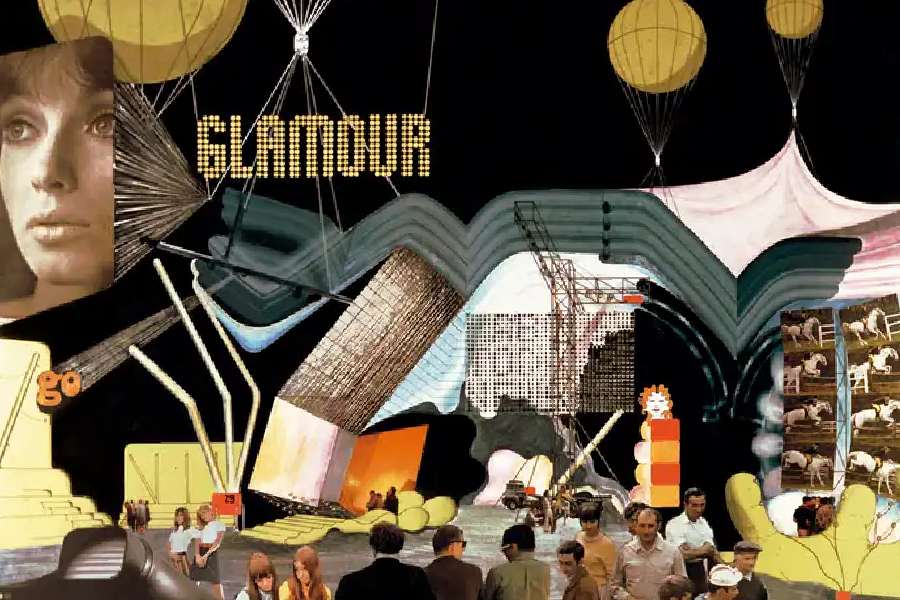Sneakers, dentures, computers — plastic is everywhere. Like a chameleon, it can go undetected, adapt to its surroundings, become invisible. And, of course, it's also used in the arts.
The virtually rotproof material's boom in the arts scene came in the 1960s, but it had already inspired avant-garde movements in Paris decades earlier.
The first sculpture made of plastic was created in 1916 by Russian sculptor Naum Gabo: "Tete No.2" ("Constructed Head No.2") a cubist head made of rhodoid, a cellulose acetate plastic used to make dolls and billiard balls.
But not all plastics are the same. When Plexiglas, also known as acrylic, came out in the 1930s, new possibilities emerged, including for artists.
Bauhaus and other artistic movements of the era experimented with transparency and reflections.
The artists of the Zero group, including Otto Piene and Heinz Mack, benefited from the possibilities this new plastic offered in the late 1950s, experimenting with plastic films to produce their light sculptures. Any material was fine for his art, said Mack. But when designers also started using plastic for furniture in pop colors, he lost interest.
Is that art, or is it garbage?
Plastic — whether hard or flexible, transparent, opaque, patterned, smooth, delicate or bursting with color — then appeared in various art forms and movements, including in pop art.
John de Andrea's 1978 female plastic nude sculpture "Woman Leaning against the Wall" is so realistic you want to reach out and touch her to confirm it's just a sculpture.
The boundaries between art and fashion blurred. Thomas Bayrle, an artist from the German city of Frankfurt, worked with a fashion studio to design plastic coats that were later sold at the Kaufhof department store chain for 25.50 Deutsche Marks (about €12, or $13).
Niki de Saint Phalle, famous for her gigantic "Nanas," also gave in to the pull of plastic. In 1968 she created inflatable balloon Nanas. As beach toys, people could take them along on a vacation.
Plastic critics
French Nouveau Realisme artists such as Christo & Jeanne-Claude, Cesar and Arman, were among the first to create artworks criticizing plastic as a symbol of consumerism and the throwaway society.
Arman created trash objects called "Poubelles" (Trash cans) in which he squeezed lots of plastic trash into a display case. "As a witness to this society, I have always been intensely concerned with the pseudo-biological cycle of production, consumption and destruction," Arman said in 1973, adding that he was long been troubled by the fact that "one of the most obvious concrete consequences of this cycle is to flood our world with junk and surplus rejects." His words sound downright visionary today.
Arman's colorful hodgepodge of "Poubelles" was intended to contrast with the enthusiastic use of plastic in pop art. For example, US artist Claes Oldenburg created XXL soft sculptures meant to represent everyday objects. He used rigid polyurethane foam, a new material that came onto the market in the 1960s and excited the art world.
Painting with plastic
Lynda Benglis, another US sculptor, was on a different path, expanding the boundaries between painting and sculpture by "painting" with latex and pigments. Her sculptural "Pools" have an undulating, organic form that almost seems to be alive because of the flow and movement of the plastic. Benglis also created a series of works in molded polyurethane foam and plasticized paper.
The sculptures of Berlin-based artist Berta Fischer, born in 1973, are all about transparency and lightness. She creates ephemeral installations out of plastic foils, nylon threads or acrylic glass, with brightly colored, reflective or transparent surfaces that appear to be classy and cheap at the same time.
The "Plastic World" exhibition at Frankfurt's Schirn Kunsthalle museum, which runs until October 1, 2023, presents art ranging from the euphoria of pop culture to the futuristic influence of the space age and the trash works of Nouveau Realisme to contemporary eco-critical works.
The exhibition shows the allure of plastic and its drawbacks, emphasizing how ambivalent the material can be. Plastic is a curse and a blessing; it is indestructible, just like the concept of art itself.










